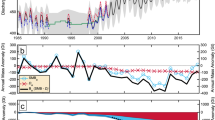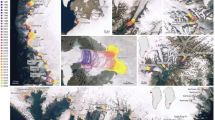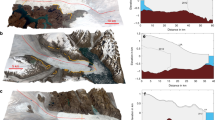Abstract
The Greenland ice-sheet would melt faster in a warmer climate and is likely to be eliminated — except for residual glaciers in the mountains — if the annual average temperature in Greenland increases by more than about 3 °C. This could raise the global average sea-level by 7 metres over a period of 1,000 years or more. We show here that concentrations of greenhouse gases will probably have reached levels before the year 2100 that are sufficient to raise the temperature past this warming threshold.
Similar content being viewed by others
Main
At present, about half of the snow falling on Greenland melts and runs off as water, and the remainder is discharged in the form of icebergs. Climate change caused by higher greenhouse-gas concentrations is expected to produce both higher temperatures and greater precipitation, but most studies conclude that the increase in melting will outweigh the increase in snowfall1. For an annual average warming of more than 2.7 °C, the melting exceeds the snowfall2 — a situation in which the ice-sheet must contract, even if iceberg production is reduced to zero as it retreats from the coast.
For a warming of 3 °C, the ice-sheet loses mass slowly3,4 and over millennia might approach a steady state in a smaller inland form. For greater warming, mass is lost faster and the ice-sheet is likely to melt away. The most extreme scenario considered in the third assessment report of the Intergovernmental Panel on Climate Change (IPCC)1 involves a warming of 8 °C; in this case, most of the ice-sheet disappears over the next 1,000 years3.
The magnitude of predicted global warming depends on the concentration of greenhouse gases and the climate response to these. We have calculated the development of Greenland's temperature using scenarios5 in which atmospheric carbon dioxide concentration stabilizes at different levels over the next few centuries (Fig. 1a). To do this, we used methods from the IPCC report1,6, in which a simple climate model is tuned to reproduce the results of a range of atmosphere–ocean general circulation models (AOGCMs); the range represents uncertainties in climate modelling. We take into account the AOGCMs' prediction that future warming in Greenland will be larger than the global average: warming is greater at high northern latitudes because the loss of snow and sea ice creates positive feedbacks, due in particular to the reduced reflection of sunlight.
a, b, Change over time in a, annual average temperature, and b, summer temperature in Greenland relative to temperature in 1990, as predicted by seven climate models1,6 (shown as seven lines for each colour) for emissions scenarios5 in which the atmospheric carbon dioxide concentration stabilizes at five different levels (in p.p.m.: purple, 450; light blue, 550; green, 650; yellow, 750; red, 1,000). For comparison, the pre-industrial concentration of atmospheric carbon dioxide was about 280 p.p.m. and that of the present day stands at about 370 p.p.m. Scenarios involving higher carbon dioxide concentrations stabilize later. Stabilization with a concentration of 1,000 p.p.m. is attained in the year 2375. Dashed lines show the threshold for the viability of the ice-sheet at 2.7 °C warming. This threshold has 50.5 °C uncertainty due to estimates (described in the Intergovernmental Panel on Climate Change's third annual report1) of uncertainties in the change in precipitation over Greenland, the calculation of melting, the geographical distribution of warming and the effects of ice-sheet dynamics.
The 2.7 °C threshold is passed in all but one of the 35 combinations of AOGCM and stabilization level; the warming exceeds 8 °C in many cases and continues to rise after 2350 for the higher concentrations. The threshold was derived assuming uniform warming through the year, but most of the AOGCMs predict more warming in Greenland in winter than in summer. The ice-sheet is sensitive to warming in summer and early autumn, but not in winter, when no melting takes place. Calculations using summer warming instead of annual average warming and allowing for uncertainty in the threshold (Fig. 1b) could reduce the number of cases passing the threshold to 24 out of 35 (69%).
The lowest carbon dioxide concentration considered was 450 p.p.m. Given that this level is exceeded before 2050 in all of the IPCC report's emission scenarios, and that carbon dioxide is not the only greenhouse gas, we conclude that the Greenland ice-sheet is likely to be eliminated by anthropogenic climate change unless much more substantial emission reductions are made than those envisaged by the IPCC. This would mean a global average sea-level rise of 7 metres during the next 1,000 years or more.
Without the ice-sheet, the climate of Greenland would be much warmer because the land surface would be at a lower altitude and reflect less sunlight. This conclusion can be drawn without detailed modelling. Even if atmospheric composition and the global climate were to return to pre-industrial conditions, the ice-sheet might not be regenerated7,8, which implies that the sea-level rise could be irreversible.
References
Church, J. A. et al. in Climate Change 2001: The Scientific Basis Contribution of Working Group I to the Third Assessment Report of the Intergovernmental Panel on Climate Change (eds Houghton, J. T. et al.) 639–693 (Cambridge Univ. Press, 2001).
Huybrechts, P., Letreguilly, A. & Reeh, N. Palaeogeogr. Palaeoclimatol. Palaeoecol. (Global and Planetary Change Section) 89, 399–412 (1991).
Huybrechts, P. & De Wolde, J. J. Clim. 12, 2169–2188 (1999).
Greve, R. Clim. Change 46, 283–289 (2000).
Wigley, T. M. L. et al. Nature 379, 240–243 (1996).
Cubasch, U. et al. in Climate Change 2001: The Scientific Basis Contribution of Working Group I to the Third Assessment Report of the Intergovernmental Panel on Climate Change (eds Houghton, J. T. et al.) 525–582 (Cambridge Univ. Press, 2001).
Crowley, T. J. & Baum, S. K. Paleoceanography 10, 357–363 (1995).
Toniazzo, T., Gregory, J. M. & Huybrechts, P. J. Clim. 17, 21–33 (2004).
Author information
Authors and Affiliations
Corresponding author
Ethics declarations
Competing interests
The authors declare no competing financial interests.
Rights and permissions
About this article
Cite this article
Gregory, J., Huybrechts, P. & Raper, S. Threatened loss of the Greenland ice-sheet. Nature 428, 616 (2004). https://doi.org/10.1038/428616a
Issue Date:
DOI: https://doi.org/10.1038/428616a
This article is cited by
-
Overshooting the critical threshold for the Greenland ice sheet
Nature (2023)
-
Time series forecasting of temperature and turbidity due to global warming in river Ganga at and around Varanasi, India
Environmental Monitoring and Assessment (2022)
-
Floods: impacts on livelihood, economic status and poverty in the north-west region of Pakistan
Natural Hazards (2020)
-
Supplementing Domestic Mitigation and Adaptation with Emissions Reduction Abroad to Face Climate Change
Environmental and Resource Economics (2017)
-
180,000 forgotten photos reveal the future of Greenland’s ice
Nature (2016)
Comments
By submitting a comment you agree to abide by our Terms and Community Guidelines. If you find something abusive or that does not comply with our terms or guidelines please flag it as inappropriate.




